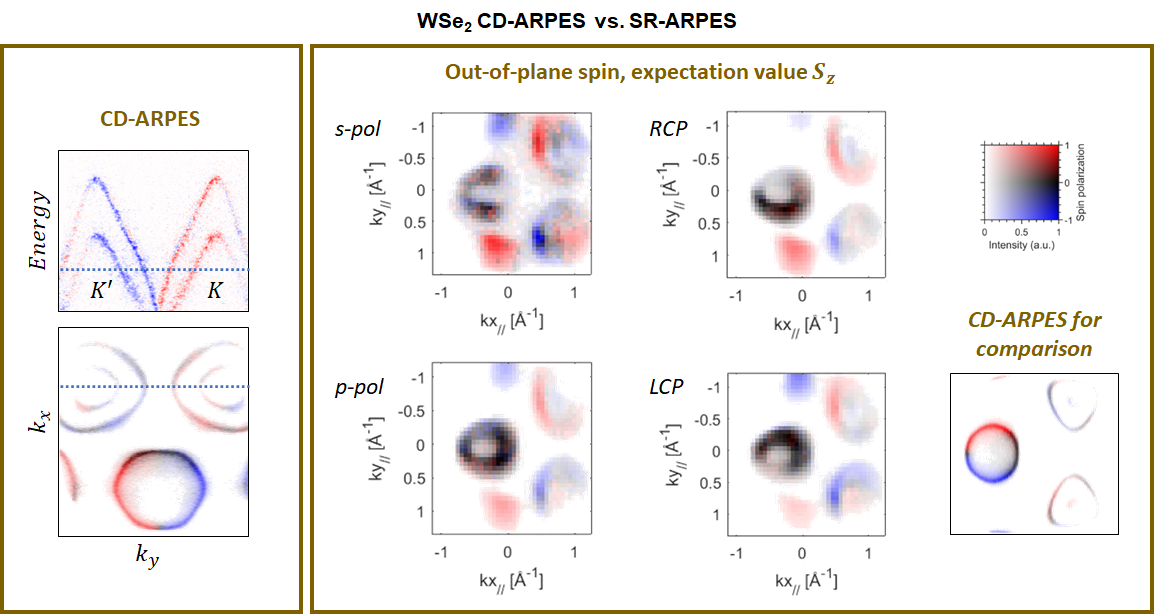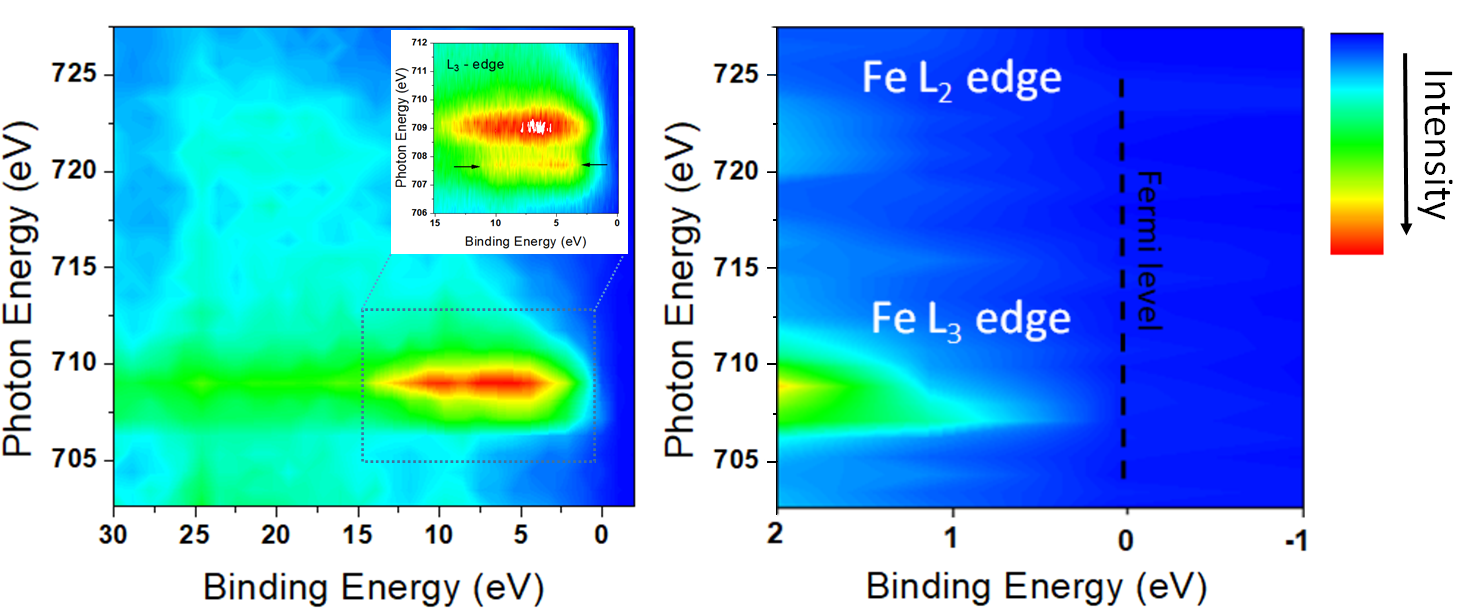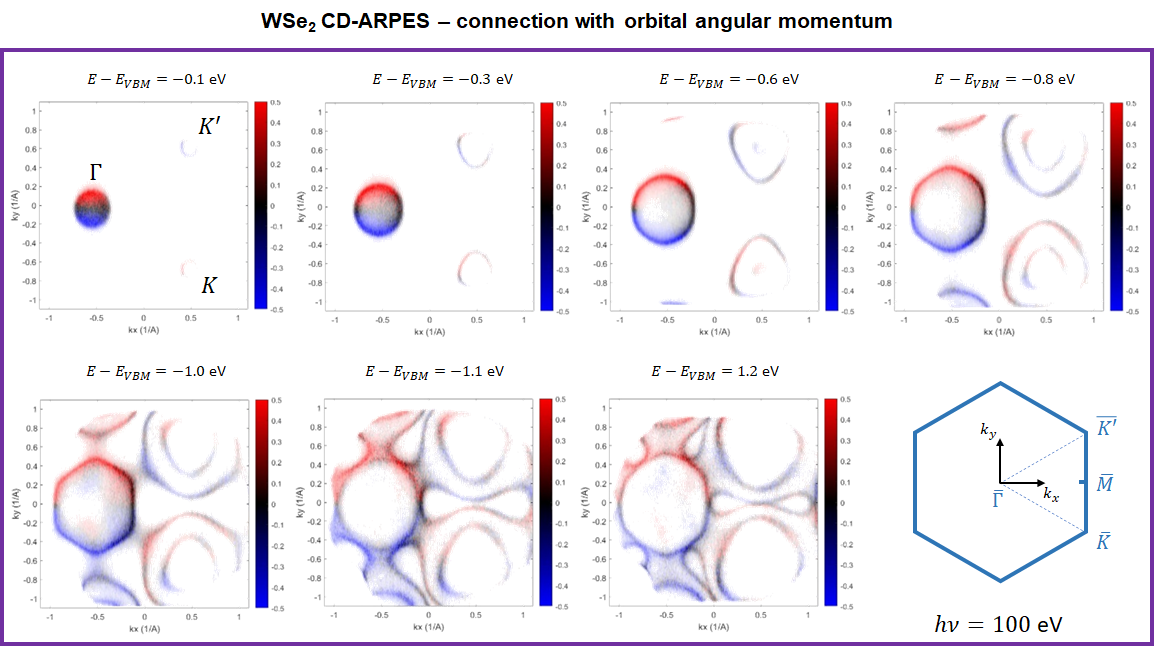Types of research
- new materials for spintronics and magnetoelectronics, topological insulators,
- thin films and multilayers systems including samples obtained in-situ,
- surface of bulk compounds,
- surface magnetism, spin polarized surface states,
- chemical reactions taking place on the surface,
- biomaterials.
Highlights
- Ewa Młyńczak from the Institute of Catalysis and Surface Chemistry PAS in Krakow, Poland
Introduction
Even though the electronic band structures of ferromagnetic materials are being studied theoretically and experimentally for decades, there are still many open questions and recent surprises which motivate further studies along these lines. For example, some recent theoretical works have shown that bcc (body centered cubic) Fe is a topologically non-trivial metal [1]. It was also recently shown that bcc Fe experiences unusual electron-magnon interaction which results in the appearance of the high-energy kink in one of the minority-spin bands [2]. Specifically, the appearance and opening/closing of the spin-orbit gaps (SOG) when the magnetization is switched were demonstrated experimentally in Fe(001) grown on Au(001) single cristal [3]. The existence of SOG near the Fermi level is crucial for many phenomena such as magnetocrystalline anisotropy, anisotropic magnetoresistance or intrinsic anomalous Hall effect [4].
Experiment
The angle-resolved photoemission (ARPES) measurements were performed on Fe(001) thin film deposited on a single crystal of Au(001). Fe film, 40 atomic layers-thick, was deposited in situ at the PHELIX end-station, at liquid nitrogen temperature to suppress diffusion of Au atoms towards Fe surface. Such a sample preparation procedure results in near-perfect crystalline quality of the obtained Fe film. The sample was remanently magnetized before measurements.
Results
Fig. (a) presents a constant energy cut near the Fermi level that represents portion of the surface Brillouin zone of Fe(001) around the M point (marked with a blue dashed rectangle on the schematic). The concentric shapes visible clearly in fig. 1 (a) represent quantum well states that exist within Fe film due to its limited thickness. Fig. 1 (b) shows the dispersion along the line marked by a red dash-dotted line, that crosses the M point. The measurements were performed using linearly polarized light of the energy equal to 70 eV. During this experiment magnetization-dependent modifications of the electronic band structure of Fe near the Fermi level have been studied.
The results were made available courtesy of Ewa Młyńczak from the Institute of Catalysis and Surface Chemistry PAS in Krakow, Poland.
References
[1] D. Gosálbez-Martínez, I. Souza, and D. Vanderbilt, “Chiral degeneracies and Fermi-surface Chern numbers in bcc Fe,” Phys. Rev. B, vol. 92, no. 085138, pp. 1–22, 2015, doi: 10.1103/PhysRevB.92.085138.
[2] E. Młyńczak et al., “Kink far below the Fermi level reveals new electron- magnon scattering channel in Fe,” Nat. Commun., vol. 10, no. 505, pp. 1–5, 2019, doi: 10.1038/s41467-019-08445-1.
[3] E. Młyńczak et al., “Fermi Surface Manipulation by External Magnetic Field Demonstrated for a Prototypical Ferromagnet,” Phys. Rev. X, vol. 6, no. 041048, pp. 1–13, 2016, doi: 10.1103/PhysRevX.6.041048.
[4] Y. Yao et al., “First Principles Calculation of Anomalous Hall Conductivity in Ferromagnetic bcc Fe,” Phys. Rev. Lett., vol. 92, no. 3, pp. 1–4, 2004, doi: 10.1103/PhysRevLett.92.037204.
Fig. 1. APRES spectra of quantum wells in thin Fe film deposited on Au(001): (a) a constant energy cut near the Fermi level, (b) the dispersion along the line marked by a red dash-dotted line crossing the M point, measured for 70eV of the photon energy and p-polarized light.
- Łukasz Pluciński’s research group from Forschungszentrum Jülich, Germany
Introduction
2D layered semiconductors are believed to be excellent candidates for next-generation electronic devices that can overcome the limitations of conventional Si-based bulk electronics. In addition to the reduction in size compared to state-of-the-art transistor devices, reducing the thickness of materials such as tungsten diselenide (WSe2) gives rise to new phenomena that could allow a completely different approach to applications of these materials such as spintronics, valleyotronics, solar cells or optical sensors [1]. Most notably, their greater resistance to short-channel effects could make them particularly promising for the development of high-performance transistors, which are key components in all electronic devices [2].
Experiment
ARPES measurements of WSe2 require stable beam position on one of the atomically flat terraces during the entire experiment. This demand is fulfilled by PHOIBOS 225 spectrometer with lens deflectors installed at PHELIX, because it provides access to ±15° in both kx and ky reciprocal directions without the need to rotate the sample. Additionally, spin texture in WSe2 is nearly entirely out-of-plane that cannot be measured with 2D spin detector. While circular dichroic (CD) textures may be efficiently measured at various ARPES beamlines, the possibility to probe Sz spin component is unique.
Results
The WSe2 bands near the local valence band maximum at K'and K points are spin polarized and exhibit spin momentum locking with antiparallel spin orientation for both branches [3]. Indeed, while measuring spin expectation values in the ensemble of photoemitted electrons at PHELIX beamline, we observed that the spin-orbit-splitted branches both at K' and K have reversed sign of the spin polarization (fig. 2.). On the other hand, band mapping in circular dichroic (CD) mode is sensitive to orbital angular momentum (OAM). CD maps exhibit antisymmetry due to the presence of the mirror plane in the chosen experimental geometry, however in this case both branches at either K' or K have the same sign of the dichroic signal (fig. 3). The difference between the spin detection and dichroic measurements is prominent also for the bands near Γ which exhibit large circular dichroism but negligible spin polarization.
The results were made available courtesy of Łukasz Pluciński’s research group from Forschungszentrum Jülich, Germany.
References
[1] A. K. Geim and I. V. Grigorieva, “Van der Waals heterostructures,” Nature, vol. 499, no. 7459, pp. 419–425, 2013, doi: 10.1038/nature12385.
[2] L. Dou, Z. Fan, and P. Xiao, “Suppression of short channel effects in 5 . 1 nm WTe 2 in-plane Schottky barrier field-effect transistors by Mo-doping,” Mater. Sci. Semicond. Process., vol. 139, no. November 2021, p. 106327, 2022, doi: 10.1016/j.mssp.2021.106327.
[3] M. Gehlmann et al., “Quasi 2D electronic states with high spin-polarization in centrosymmetric MoS2 bulk crystals,” Sci. Rep., vol. 6, no. June 2015, pp. 1–6, 2016, doi: 10.1038/srep26197.

Fig. 2. Comparison of circular dichroic and spin texture for WSe2 sample collected at PHELIX beamline for 100 eV of photon energy.
Fig. 3. CD-ARPES spectra of WSe2 sample for 100 eV of photon energy collected at PHELIX beamline.
- Anna Bajorek from the University of Silesia in Katowice, Poland
Introduction
Spinel ferrite nanoparticles (SF-NPs) are currently under intense research due to their wide range of potential applications in electronics such as magnetic memory storage devices or microwave, radiofrequency, and optoelectronics devices. They are also used as permanent magnets, in magnetic fluids technology and in photocatalysis and biomedicine application, e.g. as targeted drug delivery systems, in magnetic resonance imaging, hyperthermia and cancer treatment [1]. In addition, a new generation of advanced SF-NPs/CNTs hybrids with tailored magnetic properties and simultaneously retaining properties of individual components emphasizing the synergic effect began to be investigated in a couple of previous years [2]. Bearing in mind various synthesis types of SF-NPs and various CNTs functionalization [3], synthesizing hybrids may expand their potential applications and make them highly attractive for new materials development.
Experiment
Studying the synergic effect in selected spinel nanoferrites/carbon nanotubes (SF-NPs/CNTs) nanocomposites in connection with their electronic structure, the research group investigated NZFO/f-MWCNTs composites (where NZFO – Ni0.5Zn0.5Fe2O4 nanoparticles [4] with a nominal composition of 5 wt. %.) synthesized ex-situ and in-situ and tested in as-received and annealed forms. The investigations were focused on the valence bands region in order to: (i) determine the characteristic features arising from C and N atoms like p and s states; (ii) investigate the charge transfer between nanoparticles and nanotubes constituents based on a determination of the work function; (iii) analyze core level lines and their modification versus the type of applied synthesis.
Results
Among various acquired data based on absorption spectra collected in the total-electron-yield (TEY) mode, the resonance photoelectron spectroscopy (ResPES) studies were performed. The map presented below for the Fe 2p-3d resonance was collected for NZFO/f-MWCNTs in-situ as-received composite as the first one in the history of the PHELIX beamline. Both iron states are visible, but those assigned to the Fe L3-edge are stronger and dominate in the vicinity of the Fermi level. An apparent resonant enhancement is present for L3 states between 15-2.5eV. The region of the Fe L2-edge shows a feeble effect compared to Fe L3. Extracting spectra from the ResPES map for L3-edge, two pronounced on-resonance excitation energies are noticable: weak resonance around hn = 707.8 eV in the range of 10.6-3.4 eV binding energies and strong, broad resonance peak 709.7 - 708.3 eV in the range 13.4-2.9 eV binding energies. The performed analysis allows to conclude that the iron states represent a mix of Fe3+ in tetrahedral and octahedral sites in spinel ferrites and probably Fe2+ as CNTs catalyst residuals or iron precipitates for in-situ composite.
The results were made available courtesy of Anna Bajorek from the University of Silesia in Katowice, Poland.
References
[1] M. S. Seehra (Ed.), Magnetic Spinels - Synthesis, Properties and Applications, InTechOpen, 2017
[2] A. Bajorek et al., Materials 15(3) (2022) 977
[3] A. Bajorek et al., J. Magn. Magn Mater., 503 (2020) 166634
[4] A. Bajorek et al., J. Phys. Chem. Solids 129 (2019) 1-21

Fig. 4. ResPES spectra collected for NZFO/f-MWCNTs in-situ as-received composite.





